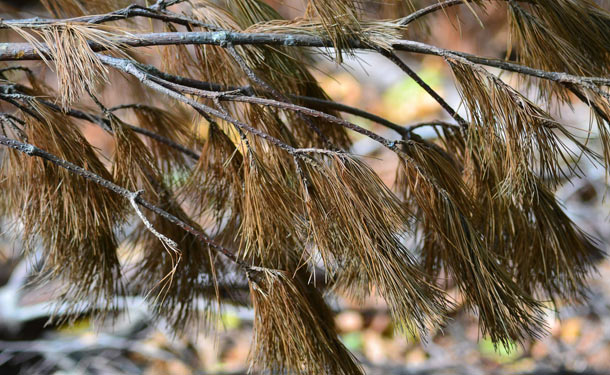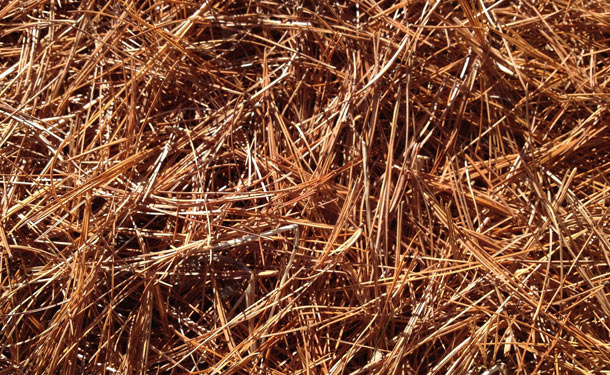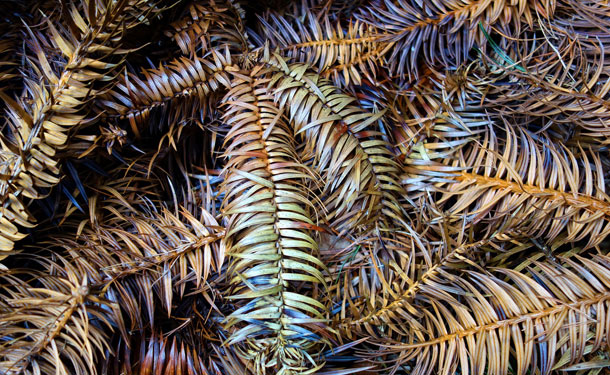
Trees like all living things have a lifecycle. During that lifecycle, they may experience periods of growth, illness, infestation, severe weather, and a myriad of other factors that may influence their livelihood, including their age.
The team at thetreecareguide.com has researched some of the leading evergreen ailments and their solutions for you to save your tree.
What Causes an Evergreen Tree to Die or Turn Brown
In order to properly treat your tree, you must first identify what is stressing it. When evergreen trees are stressed, they are not shy about showing symptoms.
The most common sign that your evergreen tree is stressed and potentially dying is the browning of a section or the entirety of the tree.

The following will help you identify and name the cause of your tree’s decline:
Evergreen Tree Diseases
NEEDLECAST – This disease is extremely common in conifers and causes very obvious symptoms. If not dealt with, needlecast can quickly propagate and spread to other trees on your property.
SYMPTOMS – The following are the three principle signs that your evergreen is infected with needlecast:
- Browning or chlorosis (loss or abnormal reduction of the green color of needles).
- Severe needle drop.
- Dieback.

TREATMENT – Keep in mind that most available fungicides are most effective when applied to new foliage or before symptoms appear. The following will help you manage needlecast:
- Prune away dead branches, twigs, and infected areas of the tree.
- Remove fallen foliage and destroy it (burn it). Do not add to compost piles.
- Apply a fungicide to the tree after removing signs of the infection.
- Deep water the tree once per week to help it recover from the stress.
RUSTS – When the “raised blisters” of this family of fungi break open, the brightly colored orange to rusty brown spores are revealed (the disease is named after this coloration).
SYMPTOMS – Once the following symptoms are detected, immediate action should be taken to control and prevent the spreading of this disease:
- Rust colored “powder” spread on the foliage.
- Often brightly colored swellings or galls on twigs and branches.
TREATMENT – As previously mentioned, most available fungicides are most effective when applied to new foliage or before symptoms appear. The following will help you manage rust disease:
- Prune away dead branches, twigs, and infected areas of the tree.
- Remove fallen foliage and destroy it (burn it). Do not add to compost piles.
- Apply a fungicide to the tree after removing signs of the infection.
- Deep water the tree once per week to help it recover from the stress.
Environmental Factors
DROUGHT – Causes damage and death of the roots. When feeder roots and root hairs die, a water deficit occurs in the tree because these roots can no longer supply sufficient water to the top of the tree.
Drought also creates an environment for secondary infestations or disease.
SYMPTOMS – Drought symptoms may not manifest in a tree for as much as 2 years after it has occurred. But they include:
- Heavy leaf or needle drop.
- Drooping, wilting, yellowing.
- Needles will show browning at the tips.
- Cracks in the bark.
- Dieback.
- Thinning Canopy.

TREATMENT – There is no cure for drought, but it can be managed. By following these preventative steps, you can reduce the effects:
- Prune back all dead or affected areas of the tree to avoid secondary infestations and disease.
- Provide the tree with one deep watering per week, allowing water to reach down 12 to 15 inches. Several light waterings will encourage roots to grow near the surface (augmenting the problem), stick to deep watering.
- In late fall (before the ground freezes) give the tree a final deep watering to help it avoid winter drought.
- Mulch the area of the root spread to help the soil retain water.
Watch this video for more evergreen watering tips.
WINTER INJURY – Evergreens are particularly susceptible to winter injury. This type of injury occurs when temperatures fluctuate abnormally during the fall, winter, and spring. A warmup in the fall, a freeze in late spring, or abnormally cold winters can all have damaging effects.
SYMPTOMS – In many cases, winter injury will not be evident until mid to late spring. They include:
- Dieback.
- Off coloring.
- Browning.
- Bark splitting.
- Heavy loss of foliage/needles.
- Needle browning at the tip and mid section.
TREATMENT – There is no “cure” once winter injury occurs. The following will help you manage the damage:
- Prune back all dead or affected areas of the tree to avoid secondary infestations and disease.
- Make sure that the tree receives one deep watering per week.
- In late fall before the ground freezes, give the tree a last deep watering to help it through the winter.
- Provide physical protection from wind and severe winter weather. Burlap wraps function well.
Your geographic region plays a role in the health of your tree. If you live in Hardiness Zone 9, learn the specific species and perfect growing conditions for Zone 9 evergreen trees.
Tips to Save Browning Evergreens
Saving a browning evergreen depends on how quickly the tree was diagnosed and what has caused the browning to occur. As mentioned in the treatments above, the following will help your evergreen recover if it is not already dead:
- Prune back all dead or affected areas of the tree to avoid secondary infestations and disease. Some cases may require extensive pruning or the removal of a portion of the tree. In this scenario, a tree professional should be called to evaluate the extent of the damage and offer direction as to which measures to take.
- Provide the tree with one deep watering per week in well drained soil, allowing water to reach down 12 to 15 inches. In soil with a high clay content, this interval may be every two weeks.
- Avoid multiple light waterings, as this will encourage roots to grow near the surface.
- In late fall, provide the tree with a final deep watering before the ground hardens or freezes.
- Mulch the area of the root spread to help the soil retain moisture. This will also help the soil retain warmth in the winter months.
- Verify the pH of the soil and its content. Make necessary adjustments to suit the needs of the tree species. Raise the pH using compounds with lime or limestone. Lower the pH using organic material, aluminum sulfate or sulfur will do the job as well.
- Fertilize only in spring and very early summer. Fertilizing in late summer or in the fall will encourage growth that will not have time to harden before winter. New growth in this manner puts unnecessary stress on the tree.
- Use fungicides to prevent reoccurrences of diseases. Apply only after having pruned away affected areas of the tree.
- Provide physical protection (especially for younger and recovering trees) during the winter season. Burlap or tree wraps work well.
If you detect that multiple evergreens are stressed and exhibiting similar symptoms, there may be a larger influence at work (including the age of your trees). If this is the case, call on a certified arborist to evaluate your entire yard or landscape.
The following video shows how fall needle drop is often confused with evergreen illness and disease. Fall needle drop is a normal process of evergreens which they will recover from.
Keeping Your Evergreen Trees Healthy
The best measure of treatment for all trees and plant life is to keep them healthy, planted in the right location, and properly watered.
For the trees you are able to recover, keep a close eye on them for secondary infections and infestations. Trees take time to heal and strengthen their defenses.
Once your trees have had problems with disease or drought, schedule an annual inspection by a certified arborist to ensure that any residual or new problems are properly addressed.
Sources:
http://www.ct.gov/caes/lib/caes/documents/publications/fact_sheets/plant_pathology_and_ecology/common_tree_health_problems.pdf
www.maine.gov/dacf/php/gotpests/diseases/factsheets/natural-needle-drop-ill.pdf
www.dummies.com/home-garden/gardening/how-to-adjust-soil-ph-for-your-garden/